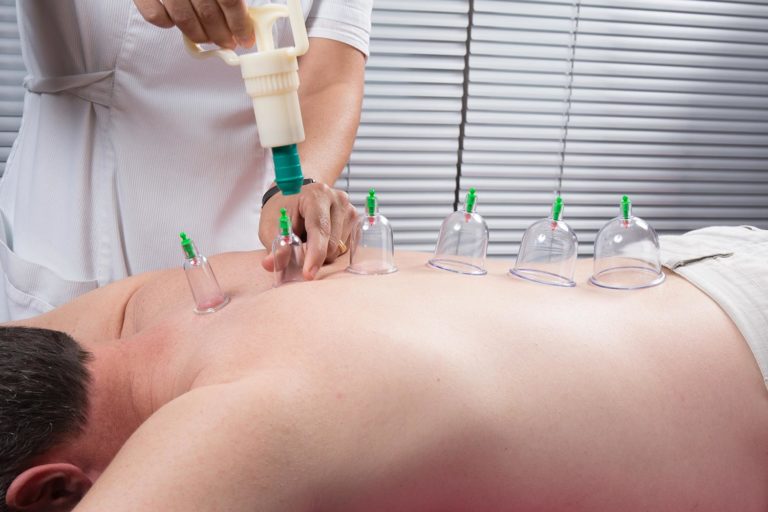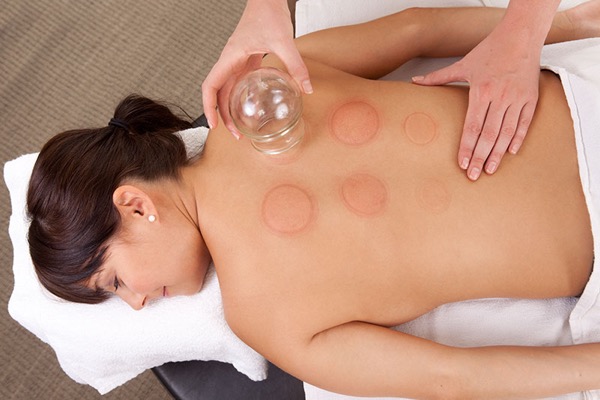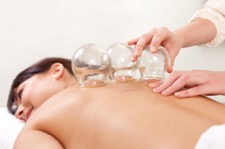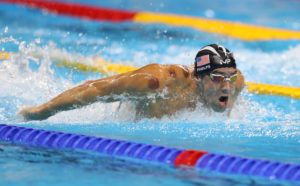
Cupping therapy was first discussed in old medical textbooks in the Western World and was described as a medical practice that was used by Egyptians. There have also been accounts of Hippocrates using the Cupping Method for internal disease. Fire Cupping has also been practiced throughout Europe, Asia, and Africa. Cupping therapy is an alternative form of medicine and is perhaps better known as a traditional Chinese Medicine, like acupuncture.
Cupping used to be performed using hollowed out animal horns and was a method employed to treat boils, snakebites, and skin lesions. The cupping method was said to pull toxins from the body. The application of cupping throughout the years has evolved from the use of animal horns to bamboo cups, and then to the glass cups, we see used today. Therapy cups can also be made from earthenware and silicone materials that can withstand being exposed to elevated temperatures during the heating process.
Several other cultures used cupping therapy as a method to treat several different ailments. The Chinese have been reported to use cupping during surgical procedures to help divert the blood flow from the surgical site. American and European doctors have used cupping to treat more common ailments such as the common cold and chest infections and congestion.
Cupping therapy, also known as hijama therapy in some Arabic cultures, is a fascinating alternative form of medicine that has received mention in historical accounts dating from possibly 5,000 years ago. Chinese Cupping Therapy is often used in conjunction with more commonly known forms of traditional Chinese medicine treatments and methods such as acupuncture and acupressure.
The basic idea behind cupping therapy is to place glass cups or silicone cups on the patient’s skin to create a vacuum, so the blood is drawn to the surface of the skin in specific parts of the body that need healing. Traditional Chinese practitioners discuss different areas, or meridians, of the body that are used to transfer energy. They believe each body has twelve different meridians and treatment can be applied to each meridian for a myriad of reasons.
Alternative medicine is defined as any form of medical treatment that is used in the place of traditional therapies or traditional and modern scientific medicine and practices. Alternative medicine claims to provide healing effects that other forms of medicinal therapy have not been proven to work. Alternative medicine is quickly growing in popularity to promote the same healing properties that can be found in traditional medicine but without the risk of same side effects
Wet Cupping
Wet cupping produces a milder suction or vacuum and can also be kept in place for up to three minutes like dry cupping therapy. However, during a wet cupping therapy session, the cupping therapist will make small cuts on the patient’s skin, typically by using a sterilized scalpel and then perform a second cupping session to draw out some of the blood. It can take up to ten days for the patient’s skin to return to normal after a wet cupping therapy session. It is important that the skin is cleaned before and after a wet cupping therapy session so that any risk of infection can be avoided.
In Arabic culture, wet cupping is also known as Hijama or medicinal bleeding. Wet cupping is popular in most Muslim areas of the world and has been reported to be used by the Islamic prophet, Muhammed.
In Chinese culture, the cupping methods are used to help improve respiratory ailments such as pneumonia and bronchitis, along with the common cold and other chest infections.
Wet cupping is a form of bloodletting and is used to remove stagnant blood, expel heat, and provide pain relief. It is imperative that the environment in which the wet cupping therapy is performed is clean and sterilized to prevent infection to the treatment sites.
Massage Cupping
During massage cupping, the alternative medicine practitioner can move the cups around and glide them across your skin, and it is recognized as a form of massage therapy. Massage Cupping has also been used for weight loss and cellulite reduction. Silicone therapy cups are more typically used for this form of cupping therapy because these therapy cups are softer and more flexible which makes it easier for the practitioner to glide them across the patient’s body.
In massage cupping therapy, the muscles are tended to with the application of pressure. Negative pressure is better to help with pain management than tissue compression. With the cupping therapy method, the skin, tissue, and muscles are instead pulled upwards to enhance circulation and provide pain management.
Massage cupping therapy also utilizes different oils so that the cup can glide easily across the back of the patient. Massage cupping is considered an alternative medicine to help with pain management and induces feelings of relaxation and stress relief to ease tension.
The Benefits of Cupping

Although modern medicine is still doubtful of the complete benefits of this therapy, scientists are increasingly conceding that in the hands of expert practitioners, it might help many patients suffering from many ailments.
Cupping therapy offers several advantages including aiding in promoting blood flow and increase blood circulation to muscles and tissue, supplies oxygen to cells, loosens knots, and can release and drain excess fluids and toxins.
Cupping therapy is based on the belief that using suction or vacuum on specific cupping points on a patient’s body can help remove obstructions in the natural energy pathways inside the body and thus cure ailments. (more on how cupping works).
Variations in the technique, such as wet cupping, in which the skin is pricked to eliminate a small amount of toxic blood and other harmful substances in the body can help prevent and treat illnesses. When combined with acupuncture, needles are first inserted into the skin over which cupping is administered and is most often followed by massage therapy.
In today’s times, there is a range of materials that can be used to craft the cups that therapists use to create suction. Ancient healers used available materials like hollowed out animal horns and bones, seashells, ceramic and bamboo, but healers today use medical standard silicone cups, rubber cups, and glass cups. The latter are most useful because they allow the therapist to watch the effect on the skin while performing the healing.
Cupping today is performed under sterile medical conditions making it quite safe. Most patients do not experience any major discomfort, but therapists might offer to provide local anaesthesia on the patient’s request. The equipment used is carefully sterilized under high pressure and temperature.
Later, the healer could perform basic massage or hydration on the cupping site to reduce the possibility of bruising. In cases where wet cupping must be administered, the therapist covers the area with antiseptic medication and appropriate bandaging to ensure speedy healing. These precautions reduce the chances of infections greatly.
By way of added precautions, therapists might also choose not to perform the healing on certain patients such as pregnant or menstruating women, patients that tend to experience high bleeding or patients with varicose veins.
There are several alternative forms of medicine today but cupping therapy is employed most often and is even an accepted method of therapy among many of the world’s athletes, including gymnastics teams and Olympian athletes. The Cupping therapy has been found to help treat certain pain associated with deep scar tissue and connective tissue in the muscles as well as muscle knots and swelling.
While Cupping therapy has gained notoriety among famous athletes such as Olympians and athletes in the National Football League, critics say that this method of therapy has no place in the world of modern medicine because there are only risks with no beneficial rewards.
No evidence suggests cupping is detrimental or beneficial to an individual. Some believe that cupping works as a placebo and just incites the feeling of well-being and healing, rather than aiding in fixing any problems or reducing the amount of pain one experiences. Currently, there is much research being done on the cupping therapy and the risks and benefits to an individual’s health and healing.
Cupping Therapy for Detoxification

Detoxification is the process of removing toxic substances from the body. Cupping is a method that has been employed for centuries for this very reason.
Cupping combines the value of building up the bodies energy with the relief of ridding the body of its toxins.
Energy flows through the twelve meridians, and the blood flows in the capillaries under the skin. The cupping method works to move the toxins towards the surface of the skin and out of the body. Once the toxins have reached the surface of the skin, it is then believed that the healing process can begin.
Cupping is a non-invasive healing method that can aid in detoxifying a person’s body and improving their overall energy. It is also said to help promote better blood circulation.
Cupping therapy has also been used to treat several other conditions including blood disorders such as anaemia and haemophilia, rheumatic diseases such as arthritis, fertility and other gynaecological disorders, eczema, acne, high blood pressure, migraines, anxiety, depression, allergies, asthma, and varicose veins.
The Effects of Cupping
After employing the cupping method, it is common to find that small bruises or redness will remain on the treated areas of the body, most commonly the back. This is due to all the blood being forced to the surface of the skin. It is believed that if there is the presence of higher amount of toxins in an individual’s body, then the redness will be deeper and more noticeable. However, the fewer toxins present in the body, the individual will experience a reduced amount of visible effects from using the cupping method.
Other side effects due to the cupping method include mild discomfort, bruises, burns, and skin infections. Before beginning any therapy that involves cupping, it is highly advised that the patient speaks with a medical doctor or traditional Chinese medicine practitioner about the benefits and risk of side effects.
Cupping is a relatively safe procedure if it is performed by a trained health professional who is knowledgeable about this practice.
Considerations Before Choosing the Cupping Method
Several things should be considered before pursuing cupping therapy. While it is safe when practiced by a professional such as a licensed acupuncturist, the patient should still want to educate themselves on the risks associated with cupping as mentioned above. It is also advisable that the patient educates and familiarizes themselves with the entire process from start to finish.
Before any cupping therapy session, the patient will discuss with the practitioner any concerns they may have as well as why they are receiving the cupping therapy. They will ask about the type of pain the patient experiences and where it is located so that they can put the cups in the most beneficial areas to help relieve some of the pain that they may be experiencing.
The back is the most common area that is used for cupping therapy because the back has five meridian lines that provide perfect placement for the cups. Depending on the conditions and the reasons the patient is receiving cupping therapy, the alternative medicine practitioner will determine how many cups to use and how long to place each cup. The time for each cup can vary between five and ten minutes depending on the severity of the condition.
While cupping may produce several bruises, and swelling on the site area, it is relatively painless. The marks experienced after a cupping session can last anywhere from a few days to a couple of weeks. The bruises are not caused due to any form of blunt trauma. Therefore, they should not hurt.
When the cups are applied to the skin, the patient may experience a tight or pulling feeling because the skin is being drawn into the cup. If this pulling sensation causes any pain, then it is advised that the patient notifies the practitioner immediately so that the technique they are employing can be adjusted as needed to accommodate the patient and provide an increased level of comfort and induce relaxation during the session.
Cupping therapy is ideal for those that are looking to improve their flow of energy, encourage detoxification of the body, relieve pain, ease tense muscles, or encourage relaxation. However, if the potential patient is prone to bleed easily or they are pregnant, then it is not recommended or advised as an alternative form of therapy and treatment.
Other conditions that should be discussed prior to using cupping therapy include:
- Anyone that is experiencing muscle spasms or have any bone fractures
- If it is suspected that that patient has an ulcer or deep vein thrombosis
- If the patient has a pulse that is easily felt by the practitioner
- And if the patient is experiencing, or may be suspected of having any form of cancer, such as metastatic cancer, that has spread from one part of the body to another part of the body
The cupping method as a traditional Chinese medicine can be used alone or in combination with another alternative medicine such as acupuncture. The suction and negative pressure that occurs during a cupping therapy session are said to help encourage blood flow and help to sedate the nervous system.
Why Athletes Use this Alternative Medicine


Many athletes are known to use the cupping method as an alternative medicine.
Some of these athletes include Michael Phelps and the USA Men’s Olympic gymnastics team, as well as some members of the USA Track and Field team.
It is a very common practice among athletes and is considered an effective treatment to increase motion and soothe sore and tired muscles. The increased blood flow to the treated areas helps to promote muscle healing. It is especially helpful when the patient is competing in a sport such as swimming, gymnastics, or track and field because they are constantly using these muscles. Increasing the blood flow will help loosen these muscles and improve the range of motion these athletes have.
Many athletes use other methods in combination with the cupping method such as manual therapy, sauna and steaming, and cold therapy compression. It is a way for these athletes to release the muscles and tendons that they are constantly using in their sport. It is also beneficial when combined with massage therapy and has been reported to help athletes considerably with their pain management during training and events.
Pseudoscience in Sports
Pseudoscience is typically the collection of practices that are mistaken to be based on a scientific method. The benefits associated with the cupping method have not been scientifically proven, but many people use pseudoscience as a more natural way to relieve their pain and a new and innovative way to relax.
While there is still research being done on the topic of the cupping method, several studies several studies suggest that it may be a viable option for pain relief or pain reduction. There, however, is still quite a bit of speculation on the effectiveness of any form of cupping therapy.
In conclusion, cupping therapy is a form of alternative medicine that is on the same level as acupuncture and phrenology. It is an alternative Chinese medicine that some people might find works well to help relieve their pain, while others believe it is a superstitious practice that produces nothing more than a placebo effect for the patient.
The cupping method is an alternative that will have to be researched to determine if it is something the individual wants to try it for themselves.
If the individual suffers from migraines, respiratory problems, high blood pressure, or any other similar symptoms and feels they have exhausted all scientifically proven assistance; then they should talk to their practitioner or a tradition Chinese medicine practitioner about cup therapy and see if they can benefit from positive results and a better pain management option.
Timeline for Results
When a patient begins to receive cupping therapy, the first few sessions may be more intense than those that follow. An individual’s body will need time to adjust to the new treatment, and as the treatments continue, the discomfort will become less, and the bruises and swelling will be less noticeable.
After a few repeated cupping therapy sessions, the patient can begin to experience feeling the need for sleep or may experience an inability to fall asleep. There may be instances of heightened smells, emotional release, and muscle soreness. The muscle soreness may mimic the effects an individual might experience after a strenuous workout. These effects will lessen as the treatments continue and will vary from person to person.
After the first cupping therapy session, the patient should experience a marked improvement in their pain levels or congestion. The symptoms they were treated for will become less and less as time goes on and the cupping therapy treatments are continued. Joint stiffness will see a noticeable improvement, and there may be improved hormone production. The muscles will begin to stretch and loosen, and inflammation should be relieved as the stagnant blood and toxins are released from the body.
The cupping therapy will begin to strengthen the patient’s immune system and facilitate the movement of Qi and blood within the body. The patient will experience an overall good feeling of health and energy beginning of the first treatment and will become more noticeable as the toxins continue to be removed from the body and the cupping therapy sessions continue.
The continuity and schedule of cupping therapy sessions should be discussed with the practitioner or cupping therapist to determine the length of time and number of treatments that will be needed to achieve the desired results. It is better if cupping therapy is performed in multiple sessions over a longer period.
Cupping therapy is safe to do on a weekly basis but as the treatments continue, the frequency of the visits can be reduced since the toxin levels in the patient’s body should be relatively low. Cupping therapy sessions can usually be scheduled weekly or monthly depending on the individual situation and concerns of the patient.
Most practitioners will wait to perform another cupping therapy session until they see that the red marks left from the previous session are almost gone entirely so that there will be no further inflammation of the skin. It is always best to let any bruises or muscle soreness heal before another session so that the level of discomfort can be reduced.
The time spent at each traditional Chinese medicine session can also be discussed. The times will vary depending on the ailments or treatments the patient is seeking. The therapy cups can be placed on the skin between three and twenty minutes at a time, with care shown not to leave them on too long to cause burning or irritation to the skin.
Cupping therapy is a suitable and affordable option if the patient is looking for a relatively pain-free and more natural approach to pain management and relaxation.
